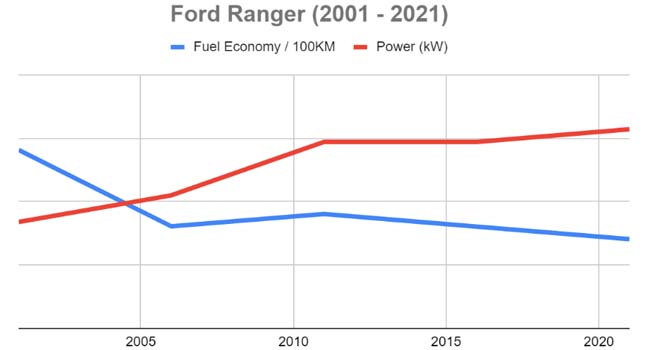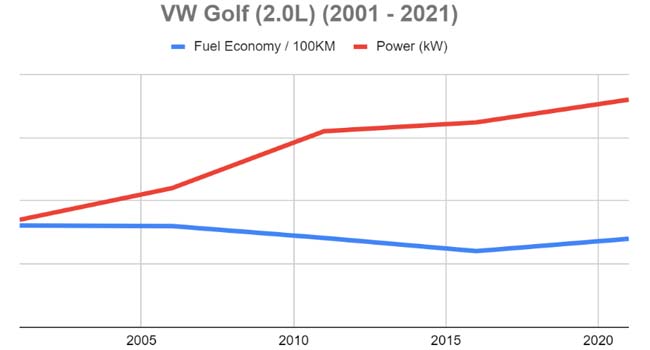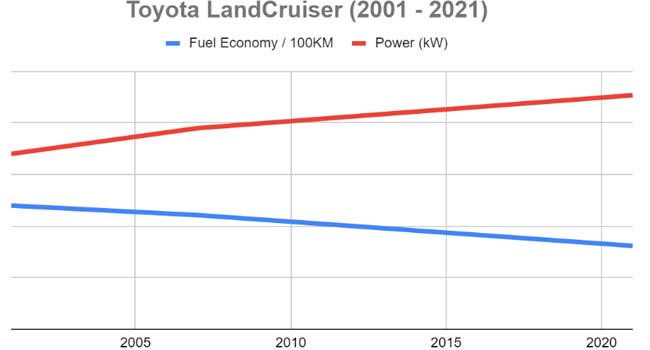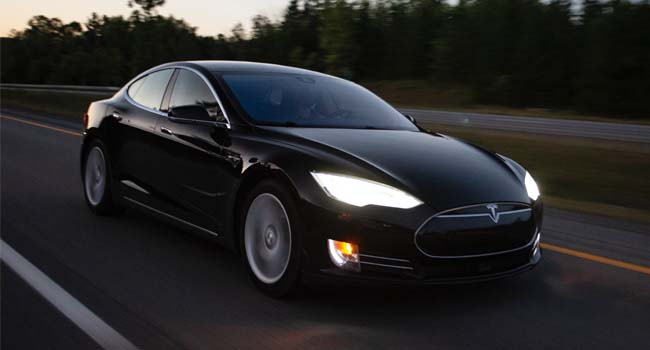October 12, 2021
For most car buyers, fuel economy is a figure almost as important as the actual price of a vehicle. The lower, the better.
Automakers have dramatically reduced the amount of fuel cars need, all while increasing the power.
But how have they achieved this sorcery?
Get the gist in 30 seconds
- Many factors, like city and country driving, hills, tyres, load and the way you drive, all have an effect on fuel economy
- An example of improved fuel economy is the 2021 Toyota Corolla which uses 18.9% LESS petrol for 47% MORE power compared to its older sibling from 2001
- A 3.5 litre engined vehicle will use around 2 litres of petrol per hour of idling
- Front and rear window design, front grilles, side mirrors all have an impact on aerodynamics and fuel economy
- Variable valve timing (VVT) reduce both fuel consumption and emissions
- Hybrid technology is cutting fuel consumption in half
Fuel economy in brief
Measured in litres of petrol per 100 kilometers (L/100KM) travelled, fuel economy simply means how much petrol a vehicle uses over the distance it travels.
But it can be tough to calculate.
City driving and country driving give different readings as you’ll typically use more petrol when stopping and starting on urban streets.
Country driving, meaning higher speeds on long highways, uses less petrol than city driving as cars maintain a constant speed over many kilometres.
You’ll often see a ‘combined’ figure for a car’s fuel economy, this figure is taking both city and country driving into account.
Some factors that affect fuel economy
- Hills – driving uphill uses more fuel than on flat terrain or rolling downhill.
- Tyre pressure – incorrectly inflated tyres can require your engine to work harder to move the vehicle.
- Load – a car full of cargo and/or passengers or towing a trailer needs more fuel to haul the load.
- The driver – driving hard by accelerating fast, heavy braking and zipping through side streets uses more fuel than calm, gentle driving.
If you see an impatient, aggressive driver on the road, remember that they’re paying for the privilege! That’s in terms of wear and tear, possible fines and poor fuel economy.
What do the numbers say about fuel economy?
“…the 2021 Corolla uses 18.9% LESS petrol for 47% MORE power.”
For starters, the trusty Toyota Corolla.
2001 Toyota Corolla (1.8L 4 cyl)
Fuel economy: 7.4L / 100KM
Power: 85kW
2021 Toyota Corolla (2L 4 cyl)
Fuel economy: 6L / 100KM
Power: 125kW
In other words, the 2021 Corolla uses 18.9% LESS petrol for 47% MORE power. Buy a hybrid for even better numbers!
Other vehicles also boast impressive figures
These three popular vehicles have made huge improvements in fuel economy and power over the last 20 years.
Note that model variants can differ from the figures below.
Ford Ranger

| Year | Fuel Economy / 100KM | Power (kW) |
| 2001 | 10.2 | 84 |
| 2006 | 8.5 | 105 |
| 2011 | 9.2 | 147 |
| 2016 | 8.3 | 147 |
| 2021 | 7.4 | 157 |
VW Golf (based on 2.0L, 4 cyl version)

| Year | Fuel Economy / 100KM | Power (kW) |
| 2001 | 8.5 | 85 |
| 2006 | 8 | 110 |
| 2011 | 7.6 | 155 |
| 2016 | 6.2 | 162 |
| 2021 | 7 | 180 |
Toyota LandCruiser

| Year | Fuel Economy / 100KM | Power (kW) |
| 2001 | 12 | 170 |
| 2007 | 11.7 | 195 |
| 2021 | 8.9 | 227 |
So how do they do it?
Automakers employ a range of techniques to save your wallet at the pump. This ultimately means more people buying their vehicles as we all look for ways to save money.
Start-stop systems
Fuel saving: up to 8% in heavy traffic
These systems turn the engine off while stopped at a traffic light, then quickly restart the engine when the driver takes their foot off the brake.
The numbers sound impressive on some cars. A 3.5 litre engined vehicle will use around 2 litres of petrol per hour of idling – not with a start-stop system.
Aerodynamics
Fuel saving: up to 10% depending on vehicle and design
The faster you drive, the more headwind the car has to push through to maintain the high speed. Therefore, the more ‘slippery’ and sleek a vehicle is, the easier it is to accomplish this.
Side mirrors, for example, often come to mind when thinking about a vehicle trying to ‘cut’ through the air. These increase a car’s aerodynamic drag by up to 7%, meaning more fuel.
Car designs have come a long way over the last few decades.
Here are a few design quirks used to dramatically improve a car’s ability to slip through the air and save you money at the pump.
- Grille openings / gaps: these help channel air hitting the front of a car
- Front and rear windows: the angle and curve of these windows helps air pass over and around the vehicle
- Diffusers: added underneath a car, these panels help tune air coming off the underside
- Air dam / front splitter: the front (nose) of the vehicle includes designs and curves to help slip through air
- Wheel design: gaps between spokes in wheels not only look good but also help air flow more smoothly around a car
- Mirror attachment arms: – subtle changes in the stalks connecting the side mirrors to the vehicle reduce drag
- Shielded wipers: some cars feature a slight raised curve on their bonnets near the base of the windscreen. This is to shield the wipers from oncoming wind, lowering drag (and wind noise)
- Smooth corners: ensuring the corners of vehicles are smooth significantly improves aerodynamics
There are many more.
An example of a vehicle with poor aerodynamics is the H2 Hummer with its sharp corners and large, wide front end.
 (An H2 Hummer)
(An H2 Hummer)
At the other end of the scale, a vehicle with excellent aerodynamics, is the Tesla Model S which has a very low drag coefficient (Cd).
 (Tesla Model S)
(Tesla Model S)
The lower the drag coefficient, the more easily an object will slip through the air.
Here are some examples
| Object | Drag coefficient (Cd) |
| Brick wall | 1.16 |
| Human (upright) | 1.15 |
| H2 Hummer | 0.57 |
| Tennis ball | 0.507 |
| Raindrop | 0.5 |
| Average bird | 0.4 |
| Nissan Skyline R34 GT-R | 0.34 |
| Tesla Model S | 0.208 |
| Boeing 747 | 0.031 |
Variable valve timing
Fuel saving: around 6% depending on vehicle and design (plus around 25% more power in some cases)
Variable valve timing (VVT) allows the timing of valves in an engine’s cylinders to change depending on engine speed (RPM).
Why would you want VVT?
The valves in an engine control the flow of inbound air and outbound exhaust gas. When these valves open and close, along with the length of time they remain opened or closed, has a significant impact on engine performance.
Without VVT, engineers tune the valve timing based on when they think the car will get best performance. For example, a family sedan at lower engine speeds and a sports car at higher engine speeds.
VVT allows for the best of both worlds.
Of course, the technology adds to the complexity of an engine, and the costs.
Benefits of VVT
Power is a big one. Some applications can deliver as much as 25% more power to the engine without needing as much more fuel.
Some systems can control the amount (or height) at which valves open meaning a larger or smaller gap for air and exhaust to pass through. This again means more control of the engine.
Some exhaust gas is also recirculated or re-entered into the engine which can dramatically improve emissions.
The only real disadvantage of VVT is a more complex engine. However, development and refinement over the years has made VVT much more reliable.
The first production car featuring a VVT system was the 1980 Alfa Romeo Spider 2000, however, the technology became mainstream in 1989 with Honda’s legendary VTEC system.
Hybrid technology
Fuel saving: over 50% in many cases
Comparing a non-hybrid to hybrid product, the 2020 Toyota Camry V6 petrol gets around 8.8L / 100KM
The hybrid version comes in at around 4.2 L/100KM.
That means the Camry V6 petrol option uses 109.5% more fuel than the hybrid.
What’s hybrid?
If you’re not familiar with the technology, it really refers to a vehicle that uses two or more forms of power. Commonly for cars, that means a petrol engine and an electric motor.
Hybrid vehicles switch between the two. Usually, the electric motor is for lower speeds and the petrol for higher speeds. This is because electric motors have high torque (turning power) which is good for taking off from a stop, while petrol engines are better at maintaining speeds.
The electric motor is charged by the petrol engine when the vehicle is travelling at higher speeds.
What’s with all the acronyms?
- EV – Electric Vehicle, like a Tesla, the vehicle doesn’t have a petrol engine
- BEV – Battery Electric Vehicle, a more specific term for EV
- PEV – Plug-In Electric Vehicle, the vehicle is electric and can be charged from an external source
- HEV – Hybrid Electric Vehicle, the vehicle uses both a petrol (or diesel) engine and an electric motor
- PHEV – Plug-in Hybrid Electric Vehicle, the vehicle uses a petrol (or diesel) engine and an electric motor. The electric motor can be charged by the petrol (or diesel) engine or from an electrical outlet
- FCEV – Fuel Cell Electric Vehicles, quite rare, these vehicles run on liquid hydrogen, only emitting warm water and air from the tailpipe
- ICE – Internal Combustion Engine, a traditional engine that uses petrol or diesel as a fuel source
Note that EV, BEV and PEV are pretty much the same for consumer vehicles.
Did you know?
The world’s first mass-produced hybrid was the humble Toyota Prius which first went on sale in Japan in 1997.
Your fuel economy
There are a lot of things you can do to increase your car’s fuel economy. However, sometimes the fastest and easiest method to keep dollars in your pocket is to simply drive calmly and fill up on low price days.
Aggressive driving, such as hard accelerating and speeding up hills, dramatically increases your fuel consumption.
Furthermore, in Australia, most populated areas, like the capital cities, have fuel price cycles. This means that prices fluctuate. Always make sure to time your refills on the cheap days.
If your car simply isn’t cutting the mustard, it might be time for an upgrade. Often, motorists decide that clinging onto an older vehicle ends up costing more than getting into a new one.
If you’re keen to upgrade your car, start with an OnlineLoans.com.au quick quote to get the ball rolling quickly and smoothly.
Sign Up to the OnlineLoans.com.au Newsletter
Get offers, contests and promos delivered straight to you inbox
